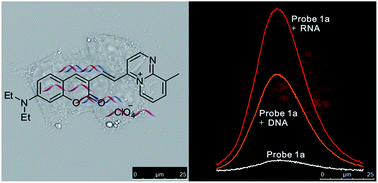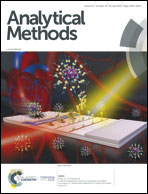Synthesis of azonia cyanine derivatives as NIR fluorescent probes for nucleic acid detection and cell imaging†
Abstract
Six azonia cyanine dyes (1a–f) based on the [1,2-a]pyrimidin-5-ium perchlorate unit were prepared to study their optical properties after interaction with nucleic acids and their potential applications in cell imaging. Dyes 1a–c consist of pyrimidin-5-ium perchlorates (4a–c) and a coumarin unit (5a) linked by conjugated double bonds, while 1d–f were endowed with different conjugated structures through the condensation between pyrimidin-5-ium perchlorates and 6-(diethylamino)-2,3-dihydro-1H-xanthene-4-carbaldehyde (5b). Due to these different structures, they demonstrate different properties. The optical properties of the dyes in five different solvents were measured; dyes 1a–c exhibited strong fluorescence in low polarity solvents (Φ up to 44.9% in dichloromethane) but much weaker fluorescence in high polarity solvents (Φ low to 1.5% in methanol), while dyes 1d–f showed no regular fluorescence properties in these solvents. Then, the optical responses of dyes 1a–f toward nucleic acid indicated that 1a–c are turn-on type near infrared (NIR) nucleic acid probes (maximum emission wavelength range: 678 nm to 698 nm) with large Stokes shifts (143 nm to 155 nm). Among these, the relative fluorescence quantum yield of 1a increased 25.2 times (from 0.4% to 10.1%) and the maximum fluorescence intensity was enhanced by 14.4 fold after interacting with RNA. Additionally, cell imaging experiments indicated that dyes 1a–c can be used to image the nucleolus in fixed HeLa cells.

- This article is part of the themed collection: Analytical Methods Recent HOT articles


 Please wait while we load your content...
Please wait while we load your content...